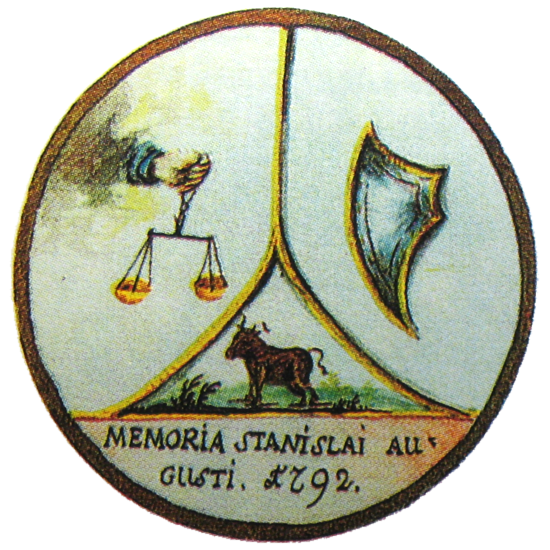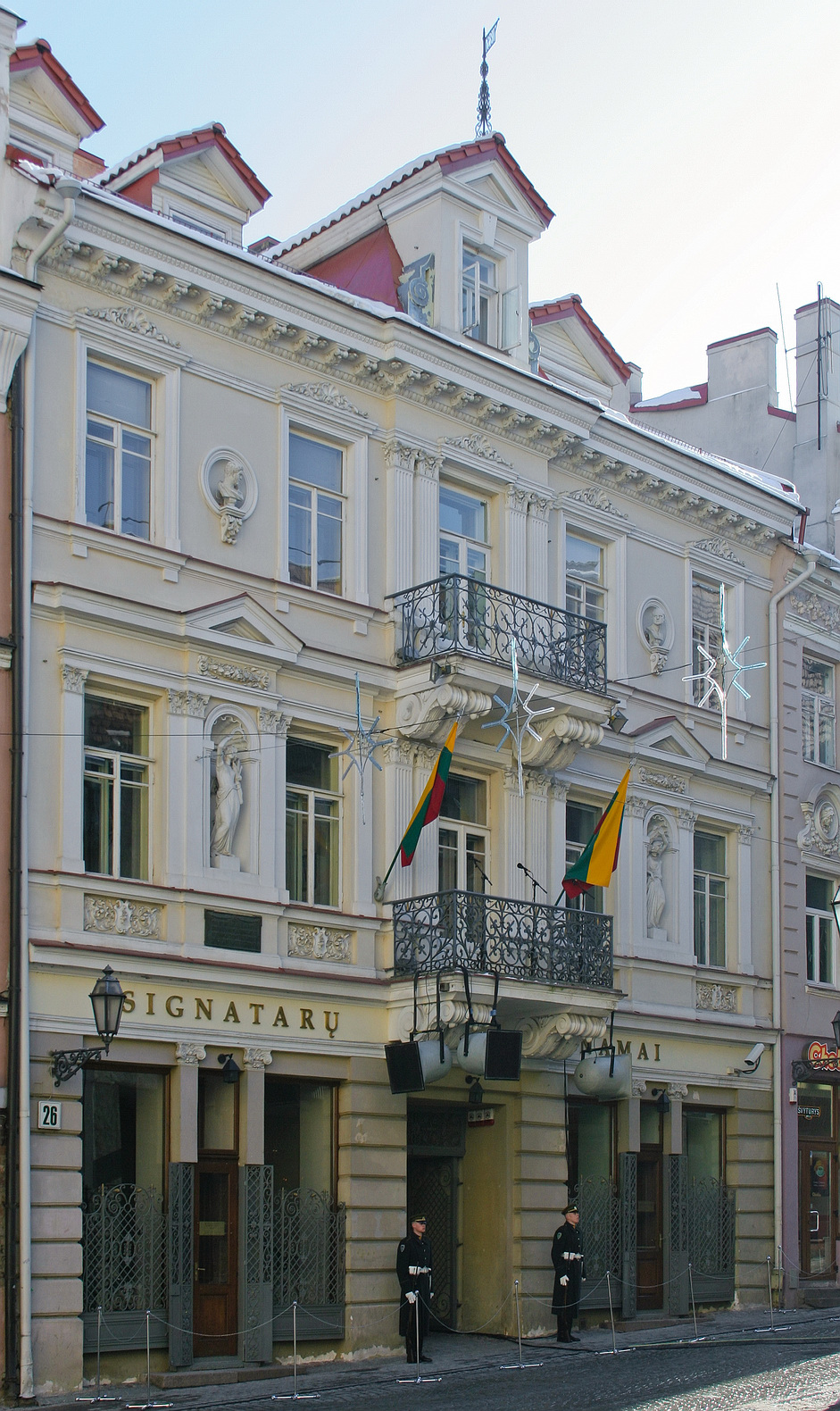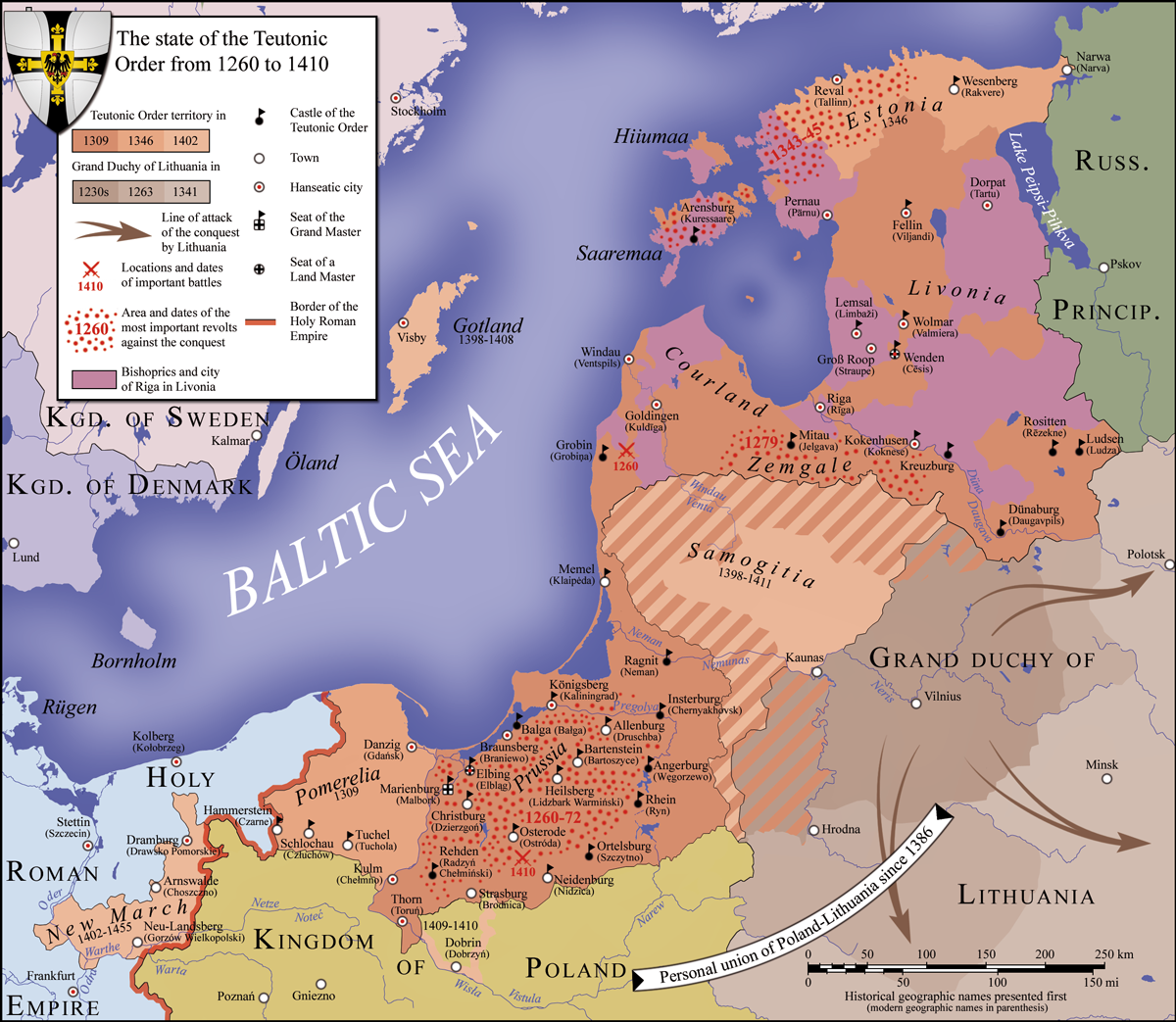|
Albertas Manvydas
Albertas Manvydas or Albertas Vaitiekus Manvydas ( pl, Wojciech Moniwid), died in 1423 was a Lithuanian noble, the first Voivode of Vilnius and founder of the Manvydai family. During the turbulent disputes over Samogitia, he was sent as a negotiation to the Teutonic Knights. Along with Stanislovas Čiupurna, Manvydas was the most influential noble during the early reign of Grand Duke Vytautas. Biography Manvydas was first mentioned in a document dated 1387–89 when he, along other nobles, vouched for Hryćka Konstantynowicza who organized a rebellion against Skirgaila, regent of the Grand Duchy of Lithuania in the name of his brother Jogaila. He was a starosta of Vilnius from 1396 to 1413. After an administrative reform that established Vilnius Voivodeship in 1413, Manvydas became the first Voivode of Vilnius and held that position until his death. During the First Samogitian uprising, he was sent on diplomatic missions to the Teutonic Knights and helped negotiate the Peac ... [...More Info...] [...Related Items...] OR: [Wikipedia] [Google] [Baidu] |
Balga
Balga (russian: замок Бальга; german: Burg Balga; lt, Balga; pl, Balga) was a medieval castle of the Teutonic Knights in Kaliningrad Oblast, Russia. The castle ruins are located on the shore of the Vistula Lagoon, north of Mamonovo in the Pogranichny municipality of Bagrationovsky District, about southwest of Kaliningrad. History The hill of Balga had been the site of an Old Prussian ( Warmian) fortress called Honeda. The fort had been unsuccessfully besieged by the Wettin margrave Henry III of Meissen on his 1237 Prussian Crusade, but was eventually conquered in 1239 by the forces of the Teutonic Order, led by Grand Marshal Dietrich von Bernheim. Balga was the oldest Ordensburg constructed by the Teutonic Order in the region of present-day Kaliningrad Oblast, and was built from 1239 to control naval traffic on the Vistula Lagoon. With the assistance of Duke Otto I of Brunswick-Lüneburg, the Teutonic Knights defeated the Old Prussians along the coastline of War ... [...More Info...] [...Related Items...] OR: [Wikipedia] [Google] [Baidu] |
Ashmyany
Ashmyany ( be, Ашмя́ны; Łacinka: ''Ašmiany''; russian: Ошмя́ны; lt, Ašmena; pl, Oszmiana; yi, אָשמענע, ''Oshmene'') is a town in Grodno Region, Belarus, located at 50 km from Vilnius. The town is Ashmyany District's capital. It lies in Ashmyanka's river basin. The town was the birthplace of the general Lucjan Żeligowski and Jewish Soviet partisan Abba Kovner. Name Since time immemorial, Ašmena and its surroundings were ethnic Lithuanian territory. However, many of the indigenous inhabitants died out during the wars, famine and plague in the late 17th and the early 18th centuries, and the number of Slavic colonists grew. Lithuanians were slavicized along the Minsk-Ašmena-Vilnius axis, and by the mid-19th century, the numbers of Lithuanian-speakers had severely decreased. Presently, its Lithuanian past is sealed in the towns's name, which is of Lithuanian origin. The town's name is derived from the name of the ''Ašmena'' (modern ... [...More Info...] [...Related Items...] OR: [Wikipedia] [Google] [Baidu] |
Vilnius Cathedral
The Cathedral Basilica of St Stanislaus and St Ladislaus of Vilnius ( lt, Vilniaus Šv. Stanislovo ir Šv. Vladislovo arkikatedra bazilika; pl, Bazylika archikatedralna św. Stanisława Biskupa i św. Władysława, historical: ''Kościół Katedralny św. Stanisława'') is the main Roman Catholic Cathedral of Lithuania. It is situated in Vilnius Old Town, just off Cathedral Square. Dedicated to Saints Stanislaus and Ladislaus, the church is the heart of Catholic spiritual life in Lithuania. The coronations of the Grand Dukes of Lithuania took place within its confines. Inside its crypts and catacombs are buried many famous people from Lithuanian and Polish history including Vytautas (1430), his wife Anna (1418), his brother Sigismund (Žygimantas) (1440), his cousin Švitrigaila (1452), Saint Casimir (1484), Alexander Jagiellon (1506), and two wives of Sigismund II Augustus: Elisabeth of Habsburg (1545) and Barbara Radziwiłł (1551). The heart of the Polish king an ... [...More Info...] [...Related Items...] OR: [Wikipedia] [Google] [Baidu] |
Vilnius
Vilnius ( , ; see also other names) is the capital and largest city of Lithuania, with a population of 592,389 (according to the state register) or 625,107 (according to the municipality of Vilnius). The population of Vilnius's functional urban area, which stretches beyond the city limits, is estimated at 718,507 (as of 2020), while according to the Vilnius territorial health insurance fund, there were 753,875 permanent inhabitants as of November 2022 in Vilnius city and Vilnius district municipalities combined. Vilnius is situated in southeastern Lithuania and is the second-largest city in the Baltic states, but according to the Bank of Latvia is expected to become the largest before 2025. It is the seat of Lithuania's national government and the Vilnius District Municipality. Vilnius is known for the architecture in its Old Town, declared a UNESCO World Heritage Site in 1994. The city was noted for its multicultural population already in the time of the Polish–Li ... [...More Info...] [...Related Items...] OR: [Wikipedia] [Google] [Baidu] |
Braslaw
Braslaw or Braslav ( be, Браслаў, Braslaŭ; russian: Браслав, Braslav) is a town in the Vitebsk Region of Belarus, an administrative center of the Braslaw District. History The town was first mentioned in 1065 as a castle in the border of the Polatsk Principality with the Lithuanian tribes. Archaeologists excavated a Viking settlement in the village of Maskachichy not far from the town. They think that Viking mercenaries were used as dependable border guards. In the 14th century, Braslaw was incorporated into the Grand Duchy of Lithuania and, in fact, became an important fortification near the disturbing line with the Livonian Order in the 14th and 15th centuries. In 1500, Alexander Jagiellon privileged the townsfolk with limited self-administration rights and a coat of arms. In 1506, the castle was presented to the widowed queen Yelena Ivanovna, the daughter of Ivan III of Russia and wife of Alexander Jagiellon, who founded an Orthodox Christian nunnery ther ... [...More Info...] [...Related Items...] OR: [Wikipedia] [Google] [Baidu] |
Vishnyeva
Vishnyeva ( be, Ві́шнева, Višnieva; russian: Вишнево, ''Vishnevo''; pl, Wiszniew; lt, Vyšniavas; yi, ווישנעווע, ''Vishneve'') is an agrotown in the Valozhyn District of Minsk Region, Belarus, near the border with Lithuania. History The town was probably established in the 14th century. In 1859, it had 72 households, totalling 900 people, of which 500 were Jews. In 1897, it had a population of 2650, including the rural neighbourhood, of which 1463 were Jews. The population of Vishnyeva in 1907 was 2,650, of which 1,863 were Jews. In World War II, the Vishnyeva Ghetto included 1,100 men, women, children and infants, and all were burnt alive by the Nazis and their local collaborators in the Vishnyeva Synagogue on 22 September 1942. Among those killed on that day was the grandfather of Shimon Peres, who later became President of Israel. Some Jews were taken to the ghetto in the nearby town of Valozhyn and killed there. Remains of a Jewish cemetery can ... [...More Info...] [...Related Items...] OR: [Wikipedia] [Google] [Baidu] |
Hieraniony
Hieraniony ( be, Геранёны) is a village (an agrotown) in Iwye District, Belarus. It is located near the Belarus–Lithuania border. It is known for the 16th-century Hieraniony Castle built by Albertas Goštautas Albertas Goštautas ( la, Albertus Gastold, links=no, pl, Olbracht Gasztołd, links=no, Belarusian/Ukrainian: ''Альберт Гаштольд'') ( – 1539) was a Lithuanian noble of the Goštautai family from ethnic Lithuanian lands of the Gr .... The village's population was 306 residents in 1792, 316 in 1905, 397 in 1970, and 1,278 in 2010. References {{reflist Agrotowns in Belarus Populated places in Grodno Region Iwye District ... [...More Info...] [...Related Items...] OR: [Wikipedia] [Google] [Baidu] |
Die Littauischen Wegeberichte
''Die Littauischen Wegeberichte'' (German for ''Lithuanian route report'') is a compilation of 100 routes into the western Grand Duchy of Lithuania prepared by the Teutonic Knights in 1384–1402. The Knights waged the Lithuanian Crusade to convert pagan Lithuanians into Christianity since the 1280s. The crusade was characterized with frequent raids into the enemy territory to loot and pillage. Since Lithuania lacked a developed road network, local Lithuanian and Prussian scouts would describe and document the best and most effective routes for the military raids into Lithuania. The reports contained brief directions using both natural (rivers, lakes, swamps, forests) and man-made (villages, nobility estates, roads, formerly inhabited places) landmarks for navigation. It also described obstacles and provided locations of good places for rest camps, where to obtain drinking water or fodder for horses. The place names were recorded in old German, therefore some of them are quite dist ... [...More Info...] [...Related Items...] OR: [Wikipedia] [Google] [Baidu] |
Benedict Makrai
Benedict Makrai ( la, Benedictus de Macra, hu, Makrai Benedek, pl, Benedykt Makrai; 1360s – after 1421) was a well-educated Hungarian noble and diplomat in the service of Sigismund of Luxemburg, King of Hungary and later Holy Roman Emperor. He is best known for his 1412–13 mission to Poland– Lithuania to mediate their territorial dispute with the Teutonic Knights over Samogitia and Masovia in the aftermath of the Battle of Grunwald (1410). His mission did not resolve the dispute and only heightened the tensions. Early life and education Makrai was probably born in the second half of the 1360s. His birthplace is not known, but speculated to be in the Szatmár County now split between north-western Romania and north-eastern Hungary. He came from the Gacsalkér branch of the Szentemágócs kindred as the son of Blaise. His brothers were Sebastian, who served as ''ispán'' of the chamber of salt ( hu, sókamaraispán, mentioned in this capacity in 1397 and 1403), and Stephen, ... [...More Info...] [...Related Items...] OR: [Wikipedia] [Google] [Baidu] |
Treaty Of Salynas
The Treaty of Salynas (german: Frieden von Sallinwerder, lt, Salyno sutartis) was a peace treaty signed on 12 October 1398 by Vytautas the Great, the Grand Duke of Lithuania, and Konrad von Jungingen, the Grand Master of the Teutonic Knights. It was signed on an islet of the Neman River, probably between Kulautuva and the mouth of the Nevėžis River. It was the third time, after the Treaty of Königsberg (1384) and Treaty of Lyck (1390), that Vytautas promised Samogitia to the Knights. The territory was important to the Knights as it physically separated the Teutonic Knights in Prussia from its branch in Livonia. It was the first time that the Knights and Vytautas attempted to enforce the cession of Samogitia. However, it did not solve the territorial disputes over Samogitia and they dragged on until the Treaty of Melno in 1422. Background When Jogaila, the Grand Duke of Lithuania, married Jadwiga of Poland and was crowned as King of Poland in 1386, he appointed his unpo ... [...More Info...] [...Related Items...] OR: [Wikipedia] [Google] [Baidu] |
Leliwa Coat Of Arms
Leliwa is a Polish coat of arms. It was used by several hundred szlachta families during the existence of the Kingdom of Poland and the Polish–Lithuanian Commonwealth, and remains in use today by many of the descendants of these families. There are several forms of the arms, all of which bear the name, Leliwa, but which may be distinguished as variations of the same arms by the addition of a Roman numeral. In 19th century during a pan South-Slavic Illyrian movement heraldic term Leliwa ( hr, Leljiva) also entered Croatian heraldry as a name for the coat of arms considered to be the oldest known symbol; Bleu celeste, a mullet of six points Or surmounted above a crescent Argent – A golden six-pointed star (representing the morning star) over a silver crescent moon on a blue shield, but also as a name for all other coats of arms that have a crescent and a mullet. Blazon Original coat of arms of Leliwa, otherwise referred to as Leliwa I include Azure Shield (in Polish heraldry, ... [...More Info...] [...Related Items...] OR: [Wikipedia] [Google] [Baidu] |



.jpg)

